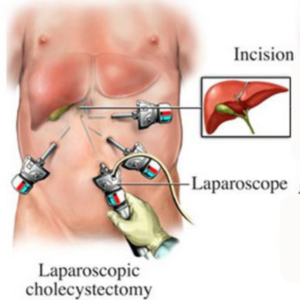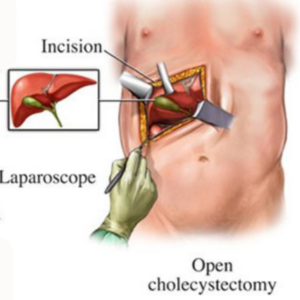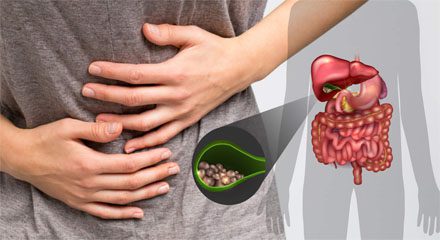Gall Bladder Treatment
Gall Bladder Treatment In Pune, Kolhapur, Aurangabad – Dr. Girish Bapat
Gall Bladder : An Overview
The gallbladder is a small, pouch-like organ situated underneath the liver. The main purpose of the gallbladder is to store and concentrate bile. The bile is stored in the gallbladder and over time it becomes more concentrated, which makes it better at digesting fats.
What causes gallstones
It is thought that gallstones develop because of an imbalance in the chemical make-up of bile inside the gallbladder. In most cases, the levels of cholesterol in bile become too high and the excess cholesterol forms into stones. Gallstones are very common. You are more at risk of developing gallstones if you are:
- Overweight or obese
- Female – women are two to three times more likely to be affected by gallstone disease than men
- 40 or over –
- A mother – women who have had children have an increased risk of gallstone disease, which may be because the hormonal changes that occur during pregnancy increase cholesterol levels
TREATMENT FOR GALL BLADDER
Nonsurgical Treatments
Laparoscopic Cholecystectomy
Open (traditional) cholecystectomy

-Noninvasive methods dissolve cholesterol-based gallstones using bile salts.
-Recurrence of gallstones is common as these methods do not prevent new stone formation.
-The dissolution process may take months or years.
-Ongoing medication may be required to manage gallstone issues.

-Incisions made in Abdomen
-Abdomen is inflated using carbon dioxide gas
-A Laparoscope inserted for viewing with camera
-Gallbladder is removed using special surgical instruments
-Gas is released through laparoscope after removal.

-Laparoscopic cholecystectomy may not be recommended in certain cases.
-Open cholecystectomy involves a large incision (10-15cm) in the abdomen.
-Gallbladder is removed through the incision.
-Conversion to open surgery is possible if complications arise during the laparoscopic procedure.
Gall Stone Symptoms
Gall stone symptoms may vary based on what type of gallbladder condition you have, although many symptoms are common among the different types of gallbladder problems. But most gallbladder symptoms start with pain in the upper abdominal area, either in the upper right or middle. Below are common symptoms of gallbladder stones:
- Severe abdominal pain
- Pain that may extend beneath the right shoulder blade or to the back
- Pain that worsens after eating a meal, particularly fatty or greasy foods
- Pain that feels dull, sharp, or crampy
- Pain that increases when you breathe in deeply
- Chest pain
- Heartburn, indigestion, and excessive gas
- A feeling of fullness in the abdomen or bloating or trapped gas
- Vomiting, nausea, fever
- Shaking with chills
- Tenderness in the abdomen, particularly the right upper quadrant
- Jaundice (yellowing of the skin and eyes)
- Stools of an unusual color (often lighter, like clay
Some gallbladder problems, like simple gallstones that are not blocking the cystic duct, often cause no symptoms at all. They’re most often discovered during an X-ray or ultrasonography or CT scan that’s performed to diagnose a different condition, or even during an abdominal surgery. If you spot any symptoms of gallbladder stones, consult
a gastroenterologist or gastrointestinal surgeon for a diagnosis and prompt treatment to get your digestive tract running smoothly again.
- Complications of Gall Bladder Stones
- Diagnosis
- Treatment
- Recovering After Gallbladder Surgery
- Empyema: Sometimes a severe infection can lead to a gallbladder abscess (empyema of the gallbladder). Antibiotics alone do not always treat these and they may need emergency drainage or surgery.
- Gallbladder perforation: Occasionally a severely inflamed gallbladder can tear, leading to peritonitis. If this happens, you may need to have antibiotics given directly into a vein (intravenous antibiotics) and emergency surgery.
- Blockage of the common bile duct. Gallstones can block the tubes (ducts) through which bile flows from your gallbladder or liver to your small intestine. Jaundice and bile duct infection (cholangitis) can result.
- Blockage of the pancreatic duct. The pancreatic duct is a tube that runs from the pancreas to the common bile duct. Pancreatic juices, which aid in digestion, flow through the pancreatic duct. A gallstone can cause a blockage in the pancreatic duct, which can lead to inflammation of the pancreas (pancreatitis). Pancreatitis can be a serious condition and requires hospitalisation and intensive care.
- Gallbladder cancer. People with a history of gallstones have an increased risk of gallbladder cancer.
Many people with gallstones do not have any symptoms, they are often discovered by chance during investigations of unrelated conditions. If you have symptoms of gallstones, you should make an appointment with a gastroenterologist or a surgeon so they can try to identify the problem.
Ultrasound scan – Gallstones can usually be confirmed using an ultrasound scan. This is a painless procedure that usually takes about 10-15 minutes to complete. Bile duct stones are sometimes seen during an ultrasound scan, but if they are not visible then further investigations such as MRI scan are needed.
MRI scan – A magnetic resonance imaging (MRI) scan may be carried out to look for gallstones in the bile ducts.
ERCP (Endoscopic retrograde cholangio-pancreatography ) – A cholangiography can give further information. It uses a dye that shows up on X-rays. The dye may be injected into your bloodstream, inserted into your bile ducts during surgery to remove the gallbladder, or inserted into your bile ducts using an endoscope (a long, thin flexible tube with a camera at the end) that is passed through your mouth. They will reveal any abnormality in your bile or pancreatic systems. If a blockage is detected during this test, your doctor may try to remove it at this point using an endoscope.
CT scan – A computerized tomography (CT) scan may be carried out to look for a complication of gallstones such as acute pancreatitis. This type of scan involves taking a series of X-rays from many different angles.
The treatment plan for gallbladder stones will depend on your symptoms. Your doctor will be able to discuss options depending on your general condition and symptoms.
Nonsurgical Treatments: Though gallbladder surgery (cholecystectomy) is the mainstay of gallbladder stone treatment if you are unable (not fit) or unwilling to go through surgery your doctor may recommend one of the several noninvasive techniques. Note that though these methods may destroy symptom-causing gallstones, they can do nothing to prevent others from forming, and recurrence is common.
Laparoscopic Cholecystectomy: Three to four small cuts are made in your abdomen. One cut (between 2-3cm) will be by the belly button and the others (each about 1cm or less) will be on the right side of your abdomen. Your abdomen is inflated using carbon dioxide gas. A laparoscope (a long, thin telescope with a tiny light and video camera at the end) is inserted through one of the cuts in your abdomen. This allows your surgeon to view the operation on a video monitor. Your surgeon will then remove your gallbladder using special surgical instruments. After the gallbladder has been removed, the gas in your abdomen will escape through the laparoscope. The cuts in your skin are closed with dissolvable stitches and covered with dressings. The operation takes 60 to 90 minutes.
Open (traditional) cholecystectomy: In some circumstances, a laparoscopic cholecystectomy may not be recommended. This may be because of technical reasons or safety concerns. During an open cholecystectomy, a large incision is made in your abdomen and your gallbladder is removed through it. The incision is around 10-15cm (4-6 inches) long and is made underneath the ribs or in the middle of the abdomen. If complications arise during keyhole surgery, such as bleeding, it may be necessary to convert to open surgery. There is around a 5% chance of this occurring.
Open surgery is just as effective as laparoscopic surgery, but it does have a longer recovery time. Most people take about six weeks to recover from the effects of an open cholecystectomy.
You’ll be taken to a recovery area as the anaesthesia drugs wear off. Then you’ll be taken to a hospital room to continue recovery. Recovery varies depending on your procedure:
Laparoscopic cholecystectomy. People are often able to go home 2 days after their surgery, though sometimes a extra one-night stay in the hospital is needed. In general, you can expect to go home once you’re able to eat and drink without pain and are able to walk unaided. It takes about a week to fully recover.
Open cholecystectomy. Expect to spend 4- 5 days in the hospital recovering. Once at home, it may take four to six weeks to fully recover.
Most people are back to normal within a week or two of leaving hospital after keyhole surgery, and can get back to work and do gentle exercise. You can usually resume strenuous exercise or work after a month. Recovery often takes longer after open surgery.
Driving – You can start driving again when you can do an emergency stop without any discomfort. Some insurance companies do not insure drivers for a number of weeks after surgery, so it is best to check with your insurance company.
F.A.Q
- Cholecystectomy is a relatively quick, common and safe procedure, but, like all operations, there is a small risk of complications.:
• Bile leak
• Bleeding
• Blood clots
• Heart problems
• Infection
• Injury to nearby structures, such as the bile duct, liver and small intestine
Your risk of complications depends on your overall health and the reason for your cholecystectomy.
- Cost depends on lots of factors such as
• Bed category
• Type of surgery
• Open or laparoscopic repair
• Choice of hospital
• Preexisting medical conditions such as diabetes, angina which may prolong your hospital stay or need critical monitoring. Following your first meeting with the doctor, we would be able to give you an approximate estimate.



